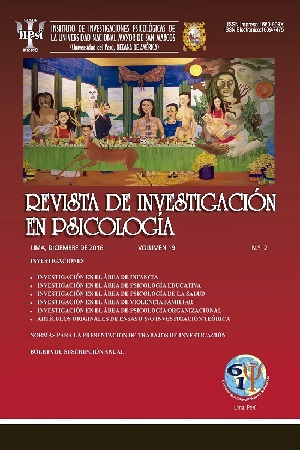Environmental quality home in rural areas children: analysis of the baseline study of the family support service of the national program “Cuna Mas”
DOI:
https://doi.org/10.15381/rinvp.v19i2.12892Keywords:
enviromental quality home, FCI, HOME, childhood.Abstract
Objectives. To know the quality standards of the home environment and explore their relationships with socioeconomic status and maternal education. Methods. Quantitative – exploratory study done between March and August 2013. We collected data from 5.859 children from 1 to 24 months. We also collected data from 5.723 mothers. We applied the Family Care Indicators (FCI) and the Home Observation for Measurement of the Environment (HOME), and a sociodemographic questionnaire. Results. Children in households with a higher level of wealth have increased availability of play materials; also most frequently performed activities in the company of an adult and in their homes has books for adults and newspapers. In households with more children of the household head, children play with fewer toys of different uses and origins, and perform fewer activities with a grownup. Most parents had practical attachment with their children while in relation to the coldness of the home, as was observed repeated prohibition to do something to one of the children and go with shouts to one of his sons. Physical punishment would be present in 3 of 10 cases. Conclusions. The evaluation has established a baseline on which will be designed and implemented a strategy that enables an improvement in key breeding practices to strengthen the National Program “Cuna Mas”.Downloads
Published
Issue
Section
License
Copyright (c) 2017 Miguel Campos S., José E. Velásquez H., Miguel Ugarelli Z., David Tarazona C., Fernando Llanos Z.

This work is licensed under a Creative Commons Attribution-NonCommercial-ShareAlike 4.0 International License.
THE AUTHORS RETAIN THEIR RIGHTS:
a. The authors retain their trademark and patent rights, and also on any process or procedure described in the article.
b. The authors retain the right to share, copy, distribute, execute and publicly communicate the article published in the Journal of Research in Psychology (for example, place it in an institutional repository or publish it in a book), with acknowledgment of its initial publication in the Journal of Research in Psychology.
c. Authors retain the right to make a subsequent publication of their work, to use the article or any part of it (for example: a compilation of their work, lecture notes, thesis, or for a book), provided that they indicate the source. of publication (authors of the work, magazine, volume, number and date).






